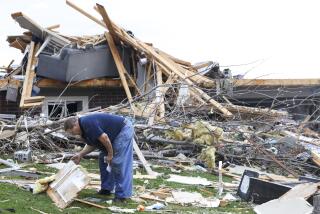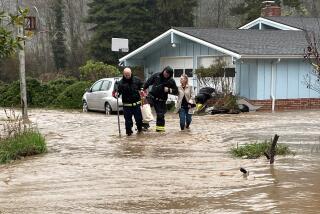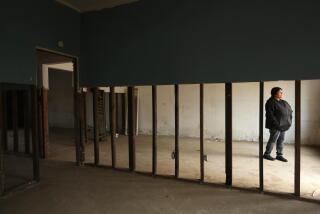Levee Break Wipes Out Historic Illinois Island : Midwest: Kaskaskia residents flee former state capital. In Des Moines, water is on tap for first time in 12 days.
As a clanging church bell sounded a warning, the Mississippi River crashed through a levee Thursday and wiped out Kaskaskia Island, a historic plug of land that was home to 150 people who held out to the terrible end.
In Des Moines, spigots shuddered, then hiccuped and finally gurgled for the first time in 12 days when a flooded-out water plant came to life. Tap water was restored to a quarter of a million people living in the largest city in America to go dry. Safe drinking water was still weeks away.
In Chester, Ill., floodwater rose in a maximum-security prison and its adjacent psychiatric ward along the Mississippi riverfront. It cut off toilet and shower water to nearly 2,500 inmates. They were taken to port-a-potties in shifts. Guards cut a 40-foot hole in a chain-link security fence to provide access for emergency vehicles.
And in Marion County, Mo., Sheriff Dan Campbell said it might have been foul play that closed the Bayview Bridge last week, the only span across the Mississippi for 250 miles at the time. He said a saboteur could have released water that blocked the bridge and threw a barge into a gasoline station, knocking down a power line and causing a huge explosion.
As damage mounted from seven weeks of flooding in the Midwest, $3 billion in emergency aid stalled in Washington, where House members argued about how to pay for it. Even $3 billion would hardly begin to cover the total damage so far, estimated at more than $10 billion. Between 30,000 and 40,000 people are homeless, and 33 have been killed.
The toll was likely to climb. Forecasters called for more heavy rain, concentrated in the Mississippi Valley. “Large and severe storms will return to Kansas, Nebraska, Iowa and Missouri,” said Steve Pryor, a senior meteorologist at WeatherData Inc., a private forecasting service. He predicted heavy rain, tornadoes and damaging wind.
The saddest tragedy was at Kaskaskia. The bell in an old brick church rang out just before 10 a.m., signaling the end of valiant efforts to save a 50-foot-high earthen levee holding the Mississippi away from the 15,000-acre island and its people.
Many had fled during the night after a bubbling sand boil erupted inside the levee. Island farmers evacuated most of the women, children and elderly. But about two dozen men and several defiant families stayed behind to save the dike. They sandbagged into the early morning.
A military helicopter hovered overhead, shining a spotlight so that they could see.
Then, at midmorning, a 60-foot section of the levee burst. Within 20 minutes, 300 feet of the wall was destroyed, and water from the Mississippi gushed onto thousands of acres of cropland. Silent as an indrawn breath, the floodwater headed toward homes and businesses that make up three villages on the island.
The helicopter flew from home to home, searching for anyone left stranded.
“We were sandbagging as much as we could,” said Denise Lankford, tears in her eyes. “But it wasn’t enough. It is so sad. People were really trying to keep everything together.”
She was among those who had fled across a western loop of the river to St. Mary, Mo. Others crossed an eastern loop to Chester. Normally, the two loops meet at the top and bottom of the island, surrounding it like a moat. But now the river was rolling over it in an awful, unstoppable sweep.
It uprooted cottonwood trees growing on top of the levee. The force of the floodwater hurled the cottonwoods off the levee and rolled them across several acres of farmland.
Lynn Wilson, an emergency worker, watched helplessly as the water hit a mobile home, bowled it over, tumbled it several times and then covered it. Fortunately, she said, nobody was inside.
As the bell tolled in the 300-year-old Catholic church, men from the levee raced into Kaskaskia, an incorporated town, and Dozaville and Hickoryville, both unincorporated villages--the only other settlements on the island.
They loaded whatever they could find into pickup trucks and drove back to a still-secure part of the levee.
Carolyn Ritter, 20, who lives with her father, Carol, 52, on a small farm outside the town of Kaskaskia, scooped a hog out of the floodwater and delivered it to the levee in a boat. The Ritter house, a three-bedroom modular home, was submerged.
Carol Ritter was able to save his tractor, a lawn mower and two dogs. But he could not lure his cat into his pickup.
“I don’t know,” he said, “if I’ll be able to go back.”
Ed Picou, 41, a native of the island, found 64 hogs perched on the slightly slanted rooftop of a neighbor’s barn.
They had swum to the rooftop in fright and huddled together, scrambling not to slip off.
With a boat, he rescued a dozen.
Other hogs swam in the water nearby. Picou was unable to reach them. Several finally made their way to the levee and crawled to safety.
Picou raced ahead of the floodwater and managed to drive 15 tractors to the levee. He also saved several other animals, including three coon dogs and a bird dog.
He stood on the levee in triumph, his polo shirt covered with slime. A hundred yards behind him was the house in which he was born. Only the top of the roof was visible.
As night fell, the levee looked like a flea market. Scattered along its unbroken portions were pickup trucks, refrigerators, sofas, chairs and patio furniture.
Two barges shuttled back and forth from the levee to St. Mary, carrying as much as they could on each trip.
Across Kaskaskia Island, the only things that could be seen above the rising water were the church steeple, the roofs of some two-story houses and some scattered treetops.
The water stank of sewage and barnyard waste. Officials warned people not to touch it. But it splashed over the sides of the barge. It was lukewarm.
In the 1800s, Kaskaskia was the territorial capital of Illinois. Then, for a while, it had become the state capital. In 1881, a huge flood moved the main channel of the Mississippi to the east and left a backwater in its old channel to the west, creating the island.
That flood wiped out the last remnant of a French fort, which had been the original settlement. It dated back to before the American Revolution. In 1741, the king of France gave the settlement a 650-pound bronze bell, intended to recognize the bravery of its residents.
The bell was rung when America became a nation. Some people from the island said it rang again, along with the church bell, when the levee collapsed on Thursday. But others said that would have been impossible.
They said its clapper had been secured to prevent vandalism.
Illinois
In Chester, across from Kaskaskia Island, floodwater from the Mississippi cut off tap water at the Menard Correctional Center, a maximum security prison.
It left 2,450 inmates with no way to shower or flush toilets. The warden brought in port-a-potties and bottled water. If necessary, he said, he would evacuate some of the prisoners to a gymnasium.
But prison officials said that the water would have to rise two or three more feet before that would happen. Many of the prisoners, said Nic Howell, a corrections spokesman, are serving 20 years or more for violent crimes.
Howell said Death Row was not affected.
The flooding closed a road leading to the front of the prison. Officials said they broke a 40-foot hole through a security fence to permit entry by way of a road that leads to the rear of the facility.
They said there was no threat to security.
In Des Moines, water service was restored to fire hydrants, homes and businesses. It was promised to industrial users by the day’s end on Monday.
L.D. McMullen, executive director of the city water plant, said that people should use the water only for flushing, showering and washing their dishes. Because of its high content of chlorine and iron, he said, the water will leave “brown blotchy things” on white clothing for at least several days.
Water safe to drink, McMullen said, was still three weeks to a month away.
City pipes have been dry since flash-flooding on the Raccoon and Des Moines rivers swamped the water plant. It turned Des Moines into the biggest city in American history without tap water. Residents have been using portable toilets and showering at friends’ homes in nearby towns.
For drinking water, they have been lining up at more than 100 distribution centers with pots, pans and jugs.
With the restoration of service, businesses and government offices that had closed for lack of water were permitted to reopen, provided that their fire sprinkling systems were recertified.
“We’re excited,” said Len Camden, general manager of the 415-room Marriott Hotel downtown. “We’ll start accepting guests tonight, but in probably less than 100 rooms.”
Noah’s Ark Restaurant, which already had contracted for a constant supply of clean water, planned to wait until the weekend before turning on its city intake valves. “We don’t want a toilet blowing up while customers are eating lunch,” said spokesman Mark Watson. “They wouldn’t like that.”
In residential neighborhoods, the return of running water was a cause for celebration.
“It’s starting!” squealed Karen Sievers, 45, as water began to splash into her bathtub. “Oooh! Just put your hands in that.”
Missouri
In St. Louis, Tom Dietrich, a hydrologist with the National Weather Service, said that the Mississippi would crest for the third time in two weeks. This time, he said, the crest would come Wednesday. It was expected to climb to 47 feet from river bottom, just shy of a record 47.05-foot crest Tuesday night.
“Levees all along the Mississippi are just incredibly stressed at this point,” Dietrich said. “There is no telling what they will do.”
Along the southern edge of the city, levees on the River Des Peres, a Mississippi tributary, were holding Thursday afternoon. But flood-battered neighborhoods braced for the worst.
Authorities posted no-trespassing signs, and police began arresting gawkers. Thousands of sightseers have hampered rescue efforts.
Trespassers faced 90 days in jail and a $500 fine.
“It is pretty sad when people get a thrill out of our misery,” said Patti Casby, 27, whose sister lives two blocks from a swamped boulevard. “If they want to help, that is one thing. But they just look and then go home to their nice dry houses.”
Several blocks away, two men filmed the devastation with a hand-held video camera. They said that they had driven 500 miles from Michigan to document the flood.
“This is a historic phenomenon, this is not misery,” said Jack Trevis, 70. His partner, Chuck Haywood, 45, agreed. “A blizzard with seven or eight feet of snow is misery.”
Town Washing Away
Kaskaskia Island was created by another flood in 1881, when the river suddenly switched course to the east. The river’s former path filled with backwater. On Thursday, Kaskaskia, Ill., was overrun by the Mississippi River.
More to Read
Start your day right
Sign up for Essential California for news, features and recommendations from the L.A. Times and beyond in your inbox six days a week.
You may occasionally receive promotional content from the Los Angeles Times.







